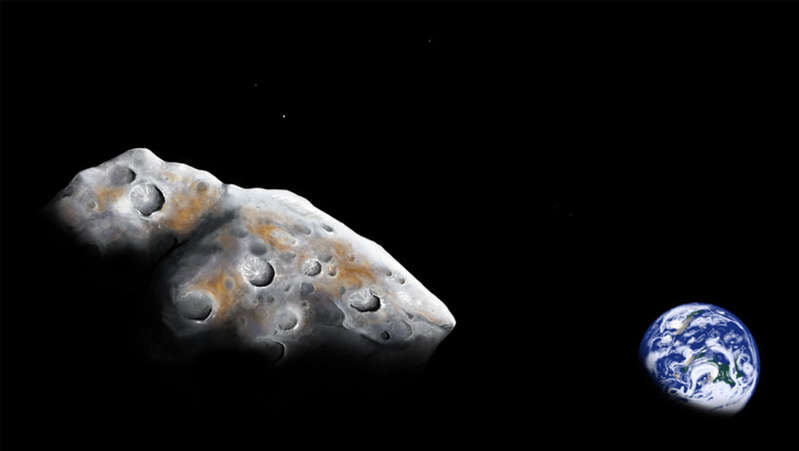
Planetary scientists estimate the economic potential of asteroids 1986 DA and 2016 ED85
A group of American planetary scientists, led by Vishnu Reddy of the University of Arizona's Moon and Planets Laboratory, studied the potential of near-Earth asteroids 1986 DA and 2016 ED85, which are 85% metal, in terms of developing the minerals they contain. An article about this was published in The Planetary Science Journal.
A new study of metal-rich asteroids is revealing information about the origin and composition of these rare celestial bodies, which could someday be developed using special robotic spacecraft. The mined metals can be used both on Earth and for construction directly in space, as well as for the creation of colonies on Mars or the Moon. Initially, these near-Earth asteroids could have formed in the conditions of the early solar system as the nuclei of future planets, which they were never destined to become. The 1986 DA is estimated to be 2.8 km in diameter, while the 2016 ED85 is 0.72-1.25 km in diameter.
“Assuming that the development of asteroids and the sale of metals will take place over 50 years, we have calculated that the annual value of precious metals (in US dollars in 2021 prices) for 1986 DA will be about $ 233 billion,” the authors of this study write. “Adjusted prices show the 1986 DA could be worth a total of about $ 11.65 trillion.”
According to scientists, who also refer to data from the US Geological Survey, the metal content in 1986 DA (also assigned the number 6178) may exceed the global reserves on Earth of several precious metals at once, and also exceed all reserves of iron, nickel and cobalt. Researchers did not include similar figures for the asteroid 2016 ED85 in their review “due to the limited amount of available data” about this object.
The advantages of mining metals on asteroids are considered not only from the point of view of economic feasibility, but also “as a way to reduce environmental damage on Earth,” the researchers remind.
“Our analysis shows that the surfaces of both near-Earth asteroids contain 85% of metals such as iron and nickel, with the remaining 15% being silicate materials, which are mostly rock,” explains lead author Juan Sanchez of the American Planet Institute. “These asteroids are similar in composition to some iron-stone meteorites found on Earth, such as mesosiderites.” Ironstone meteorites are divided into two main classes depending on the composition of the silicates they contain – they are divided into pallasites, where olivine predominates, and mesosiderites, where pyroxene and plagioclase predominate.
Planetary scientists build their conclusions on the basis of data obtained from the ground-based infrared telescope NASA IRTF (Infrared Telescope Facilityс), which is part of the Mauna Kea observatory, as well as other ground-based instruments. Spectroscopic data in the near infrared region show the similarity of the composition of asteroids 1986 DA and 2016 ED85 with the characteristics of other metal-rich asteroids, and their composition is similar to the asteroid Psyche, also known since 1852 (16), for which NASA is preparing a special mission for the spacecraft arriving there in 2026 year. Researchers call the studied asteroids “mini-psyche.” Psyche itself, due to the high content of metals in it – iron, nickel, copper, gold and platinum – can cost 10 thousand quadrillion dollars, however, “mini-psyche” are interesting because they are located much closer to the Earth, so their research and development can require much less effort and resources.
The authors note that when asteroids collapse, they give rise to “families of asteroids” – a series of smaller debris that have similar composition and orbital trajectories. Researchers studied the composition and orbits of asteroids 1986 DA and 2016 ED85 and discovered four possible families of asteroids (Phaeo, Brasilia, San Marcello, and 1999 CG1) in the outer main belt of asteroids that may be associated with them. “It is possible that some of the iron and ironstone meteorites found on Earth could also have come from this region of the solar system,” said co-author David Cantillo of the University of Arizona.
The Main Belt contains the largest known metallic asteroids, including Psyche. However, experts do not see a direct connection between Psyche, 1986 DA and 2016 ED85.
The upcoming expedition to Psyche attracts a lot of public attention also because of the prospects for mining on it, but scientists are interested primarily in the opportunity to learn something new about the origin of planetary nuclei. The diameter of this asteroid is about 250 km. Planetologists believe that Psyche is the bare core of a failed protoplanet, which, with a fortunate coincidence, could become as large as Mars, but lost its outer shell as a result of a series of collisions with other objects.
The launch of the Psyche automatic interplanetary station to the asteroid is planned to be carried out using the Falcon Heavy launch vehicle in 2022. The spacecraft will use solar panels and xenon motors that draw on this solar energy – Hall effect motors with high thrust. In 3.5 years, the device will cover 2.5 billion km and will enter orbit around Psyche in early 2026. There he will be engaged in mapping the asteroid, and will also clarify the chemical composition of its surface using gamma radiation and neutron spectrometers. Psyche is slated to remain in orbit around the asteroid for at least 21 months.
However, the discussion of the prospects for the industrial development of asteroids still arouses the most controversial comments from specialists. Someone is already predicting a new space race associated with mining in space, panic on the stock exchanges and almost armed clashes for the most promising and convenient asteroids for development. However, most experts still consider these prospects very remote and vague, since at present the cost of delivering materials from space exceeds the cost of any precious metals, not to mention the complexity of their extraction far from Earth.

